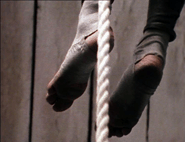Before Les Films du Renard released its first installment of an anticipated three boxset Stephen Dwoskin anthology earlier this year, there seemed little room to reconcile Dwoskin’s cinema between the transgressive, borderline pornographic gaze of Dyn Amo and the intimately melancholic Dad (an elegy to his late father Henry Dwoskin) – the only two films I had managed to see of Dwoskin’s work until then. But somewhere between the interminable claustrophobia of the de-eroticized, writhing exotic dancers of Dyn Amo and the dramatic transformation of Dwoskin’s father from virile, larger-than-life everyday hero to slender, bespectacled elderly man, is this intersection of awareness of the human body in all its evocations, sensations imperfections, limitations, and evolutions – its physicality and mortality – and it this underlying convergence that is revealed throughout Dwoskin’s cinema. Indeed, inasmuch as Dwoskin’s debilitating childhood infirmity and subsequent disability from polio provides, to some extent, a window into this acute awareness of the physical – and more specifically, a sensibility that has led to an aesthetic of awkwardness, imperfection, and stasis that Swiss film theorist and author François Albera would refer to as a cinema of “hinderedness” – there is also a deliberate nature to the transfixing slowness of his intimate gaze: not only towards an awareness of time and the toll of its inevitable passage, but also its reflection of the intrinsic discomfort of the extended gaze – the oppressiveness of “being looked at” that comes with the conscious regard of the other. In this respect, Dwoskin’s cinema may be seen, not solely in terms of the convergence between the physical and the ephemeral, but rather, in a more thematically overarching aesthetic of temporal intersections and, in particular, those that occur within the human act of seeing – when the gaze transforms from curiosity to voyeurism, from information to imagination, from peripherality to fixation.
In Pain Is…, Dwoskin’s thoughtful rumination on the nature of pain, this intersection occurs in the conceptual mechanism of pain itself, in the way it surfaces amorphously, imprecisely, throughout the process and conduct of life, as well as in its insidious ability to create a subconscious shift in (sensorial) awareness – in essence, to reconfigure (if not transform) one’s immediate reality because of its existence. It is this untenable quality of pervasiveness and indefinability that Dwoskin articulates in an introductory analogy that sets the tone for the film’s organic (and inherently circular) exposition:
“In the search, it became apparent that pain plays a part in all levels of life: in religion, in sports, in work, in sex, in politics. Not just pain itself, but all the things that pain produces: like pleasure, amnesia, complaint …When you rub your finger on the wood, you feel the wood. If you get a splinter, you feel your finger. That’s how pain works. It moves from outside to inside.”
Punctuated by the decontextualized, low-grade video footage of a nude, face obscured, convulsing woman – an image that is repeated towards the end of the film – Dwoskin illustrates the intrinsic ambiguities of these amorphous intersections, as the same footage alternately evokes images of psychiatrically-induced spasm, involuntary seizure, hysteria, and rapture – a complexity of interpretation that has been enabled by the uncomfortable extendedness of the already transgressive image. (Note that the surveillance video also becomes implicitly voyeuristic in its prolonged clinical observation and reinforces the conceptual theme of the function of the extended gaze that runs throughout Dwoskin’s oeuvre).
This cognitive extraction of the multiple meaning intrinsic within images through the conscious manipulation of time is also reflected in the parallel imagery that structures the film (a dualism that is encapsulated by the bookending shots from the corridor of a hospital): the image of a trapeze artist suspended by a series of ropes that is repeated in the image of a woman indulging in a bondage fetish, a man with impaired speech communicating through an interpreter that is mirrored in a patient who expresses his pain by playing the drums (note the image of surrogate instrument that is also represented by the interstitial sequence of a guitar ballad performance), a tattoo parlor patron wincing at the process of obtaining her body art that is contrasted against a tattooed performer unable to feel the pain of her self-inflicted piercings, an anatomic model used to illustrate abdominal organs that is evoked during a conversation with a middle-aged woman describing her desperation to alleviate the pain of her menopause-related symptoms, an implicitly contradictory exposition on the nature of pain: first, from a physician who acknowledges the inexactness of diagnostic descriptions used to help isolate the cause of the physical ailment, and subsequently, from a psychiatrist who explains the theoretical source of all pain through the commonality of stimulus-response. In this respect, Dwoskin’s films can be seen, not only as an idiosyncratic realization of adaptive encumbrances, but also as a cinema of implication in which the uncomfortable, extended gaze facilitates, not only the complexity of inferences and re-assembly of interconnected associations behind the awkward images, but more importantly, the process of interactivity that is intrinsic in the act of seeing – the implication of the spectator as voyeur, complicitor, archaeologist, and self-author.
© Acquarello 2006. All rights reserved.
